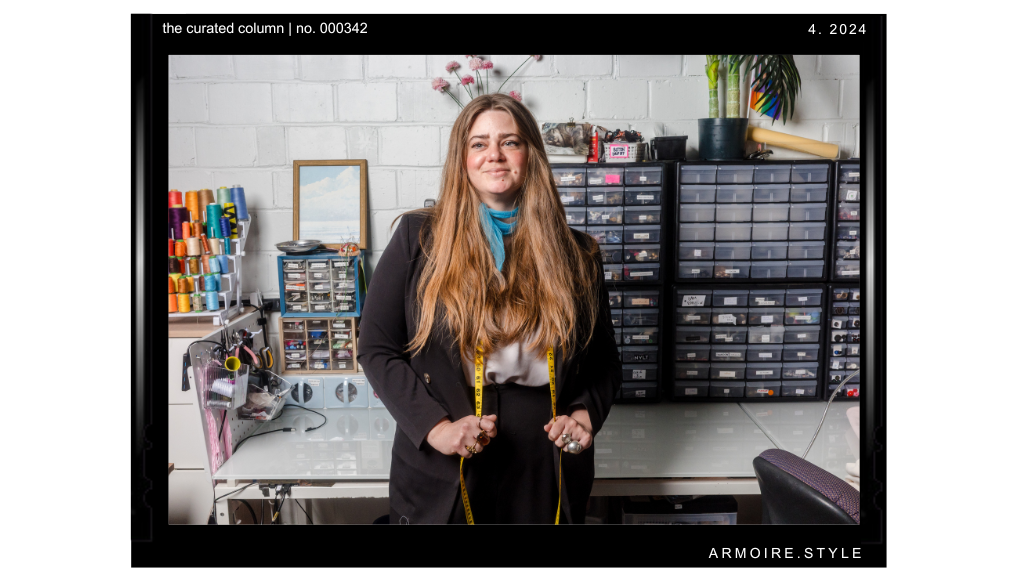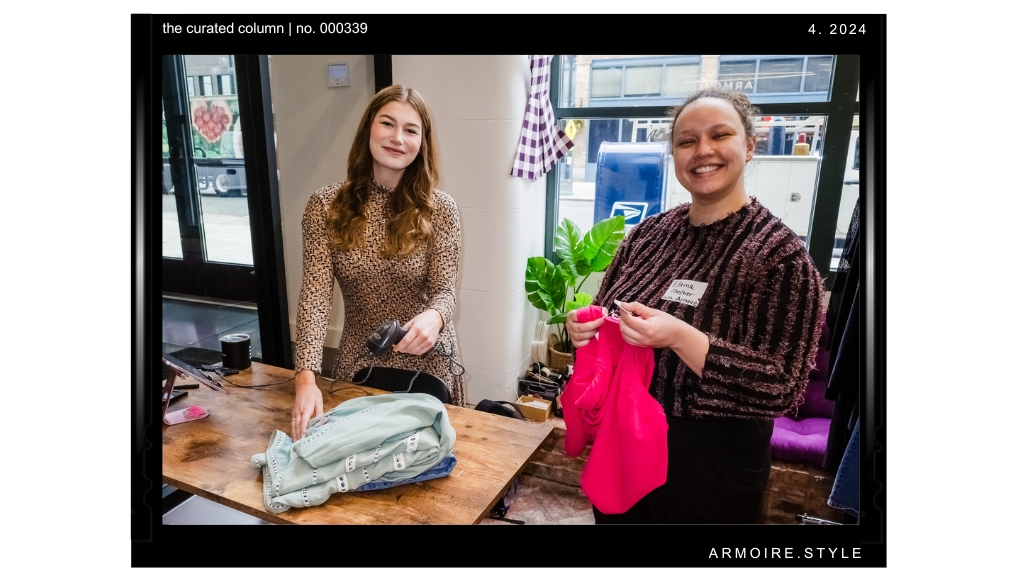
9 minutes
In honor of Earth Week, we want to shine a bright light on upcycled fashion. We have a little-known upcycling initiative here at Armoire, but it’s one with a big purpose. A talented, full-time upcycler on our team, Sam Martin, is tasked with reinventing damaged garments to spare them from the landfill, with a goal of producing 300 creations per month. Her designs have been popular in our rental inventory for years.
Upcycled fashion involves various techniques such as altering, embellishing, or combining different pieces to create something entirely new. It represents a holistic approach to fashion that combines environmental consciousness, creativity, and social responsibility to create positive change within the industry and beyond.
Upcycling vs. recycling
Both upcycling and recycling play important roles in reducing waste, conserving resources, and promoting sustainability, but they differ in their methods, objectives, and outcomes.
Upcycling in fashion refers to the process of taking discarded or damaged clothing and transforming them into new garments or accessories of higher quality or value. Unlike recycling, which involves breaking down materials to create new ones, upcycling focuses on creatively repurposing existing materials to reduce waste and environmental impact. Upcycled items typically retain some or all of the original garment’s form and function but may be altered, embellished, or combined with other materials to create something new and unique.
The goal of recycling is to divert materials from landfills and conserve resources by processing them into new materials suitable for manufacturing. For example, in the fashion industry we see fabrics made of recycled plastic bottles. Recycling often requires energy and resources for collection, sorting, processing, and manufacturing, but it helps reduce the demand for virgin materials and minimizes environmental impact. At Armoire, textile recycling is our last resort in our commitment to expanding the lifespan of the garments in our care. It’s an option we’re happy to have—nothing from our inventory goes to the landfill.
Repurposing with purpose
Upcycling not only reduces the amount of textile waste but also promotes creativity, resourcefulness, and sustainability within the fashion industry. By giving new life to discarded items, upcycling helps extend the lifespan of materials and decreases the demand for new resources. It conserves resources by minimizing the need for raw materials, energy, and water typically required in the production of new clothing. Because it promotes the reuse of existing materials, it reduces the environmental impact associated with extraction, processing, and manufacturing. Upcycling encourages consumers to reconsider their consumption habits and opt for more eco-friendly alternatives, contributing to the overall sustainability of the fashion ecosystem.
The red carpet goes green with upcycled fashion
Several celebrities have been spotted wearing upcycled fashion pieces, cementing the craze and raising awareness about the environmental and social issues associated with the fashion industry.
Model Gigi Hadid has been photographed wearing upcycles, including a gorgeous patchwork cardigan from Ukrainian designer Ksenia Schnaider. At the 2023 SAG Awards, Cate Blanchett turned heads in an exquisite Armani Privé gown crafted with repurposed lace from a dress she wore back in 2014. Shiloh Jolie-Pitt made a striking appearance wearing a dress previously donned by her mother Angelina Jolie, notably shortened from its original form. In 2019, Kate Middleton made a fashion statement by donning the same floral Alexander McQueen gown she had worn two years earlier, although revamped with a cap sleeve.
When the tastemakers of style embrace upcycling, the rest of us take notice. Some of the biggest fashion labels have opened their own upcycling departments, much like Armoire. Great minds think alike, including Hermes, Prada, and Miu-Miu.
Yes, upcycled fashion is green, but it’s also just really cool
Wearing upcycled clothing offers a unique appeal that extends beyond just sustainability. Pieces are one-of-a-kind, making them inherently unique. Each item carries its own history and character, reflecting the creativity and craftsmanship of the designer. This exclusivity adds allure, allowing wearers to stand out from the crowd.
Upcycling fosters creativity by challenging designers and artisans to think outside the box and reimagine materials in new and unexpected ways. It encourages experimentation with techniques, textures, and styles, putting it at the forefront of innovation. Makers push the boundaries of traditional fashion and pave the way for new trends and movements. Embracing upcycled clothing signals a fashion-forward mindset and a commitment to supporting sustainable practices within the industry.
Upcycled clothing celebrates imperfection and quirkiness, embracing the unique characteristics and flaws of the materials used. Whether it’s a patchwork of different fabrics, visible mending, or asymmetrical designs, upcycled pieces carry a sense of authenticity and charm that sets them apart from mass-produced garments.
Each piece comes with a story attached, whether it’s the origin of the materials used, the inspiration behind the design, or the journey of transformation from old to new. When we wear upcycled fashion, we can share these stories and spark conversations about sustainability, creativity, and conscious consumption, adding depth and meaning to our wardrobe choices.
Embracing upcycled clothing signals a fashion-forward mindset and a commitment to supporting sustainable practices.

Meet our textile artist, Sam Martin
The genius behind our upcycled collection belongs mostly to resident textile artist Sam Martin. How does one become a full-time upcycler? A Michigan native, Sam was largely self-taught in sewing and design until 2015, when she enrolled in fashion school in Seattle. It was in 2017 when Sam found her way to Armoire, also based in Seattle, where she’s been lending her talents ever since.
Sam’s passion for sewing and her commitment to her craft shine through in every stitch. On a typical day, Sam’s routine at Armoire involves tackling various tasks, from regular alterations like fixing buttons and hems to engaging in the creative process of upcycling. She aims to create 300 upcycled garments per month, with support from the Armoire team to photograph her creations and list them for rent on Armoire.
Six questions for Sam, Upcycled Fashion Magician
Q: How does upcycling fit into Armoire’s business?
A: Upcycling for Armoire is re-styling, repairing, and re-imagining our damaged inventory so it can be saved from the landfill and given a new life. The main reason we upcycle is for sustainability. We want to combat the waste in our industry as much as we can and this means using our damaged clothing to repair others, thus working toward circular fashion. We take what is old and mend it into something new again and that is a beautiful thing.
Q:What are some common challenges you face when upcycling garments, and how do you overcome them?
A: Time. We try to do upcycles in a timely manner, but sometimes garments have damage in difficult spots. Finding a creative and efficient restoration for the garment can be a challenge.
Q: What are some of your favorite upcycled creations you’ve made and why?
A: This is a tough question for me to answer. I love dramatic pieces like big, oversized sleeves, ridiculous ruffles, things like that. Anytime it makes sense for me to give a garment something like that, I’m happy.
Q:How do you stay inspired and creative in your upcycling process?
A: I live to sew and I’m constantly taking inspiration when I’m out and about, from magazines, old movies…I could go on and on. For me, the material itself will inspire me and sort of tell me what to do with it.
Q: Do you have any tips for those who want to spare their own clothes from the landfill?
A: Do it! You don’t have to go to fashion school to repair your own clothes or even to upcycle them. I would recommend asking a friend or loved one who knows how to sew to give you a lesson or utilize YouTube for some tutorials. There is a video for just about anything you want to learn. I have used it myself and continue to do so to learn new things. I am a visual learner, so being able to pause and re-watch is immensely beneficial.
Q: Are there any particular techniques or tools you find essential for upcycling
A: A serger certainly helps with upcycling. It makes patch-making so much simpler. We get to use our creative problem-solving skills the most when upcycling, seeing what a ‘damaged’ item could look like after we take our scissors to it and how we can make it stronger so it stays free from the landfill for as long as possible.
About Earth Week
Earth Week is an annual event dedicated to raising awareness about environmental issues, promoting sustainability, and inspiring action to protect the planet. It typically takes place during the week leading up to Earth Day, which is celebrated on April 22nd each year. Earth Week activities and events vary widely and can include community clean-up initiatives, educational workshops, tree planting projects, environmental advocacy campaigns, and discussions on topics such as climate change, conservation, and renewable energy.
Earth Week serves as a reminder of the importance of environmental stewardship and the collective responsibility to safeguard the Earth for future generations. It provides individuals, organizations, and communities with opportunities to come together, take meaningful action, and make a positive impact on the environment. Earth Week also highlights the interconnectedness of environmental, social, and economic issues, emphasizing the need for sustainable solutions that benefit both people and the planet.
Through Earth Week, people around the world are encouraged to reflect on their relationship with the environment, adopt sustainable practices in their daily lives, and advocate for policies and initiatives that promote environmental protection and conservation. By raising awareness and fostering collaboration, Earth Week plays a crucial role in mobilizing efforts to address pressing environmental challenges and build a more sustainable and resilient future.










